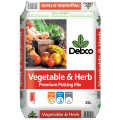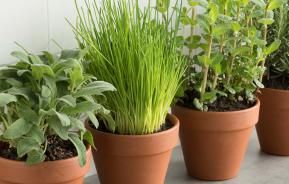Growing your own fruit and vegetables is one of the most rewarding things you can do in the garden. It’s a great way to learn about caring for your plants, and there’s nothing quite like freshly picked, home-grown produce for superb flavour and great nutritional value!
Plus, it can help you reduce food waste and can save you money. It’s no wonder it’s becoming more and more popular amongst people that want a more sustainable lifestyle.
Here are our ‘Top 10’ easy steps to getting started:
Jump to:
- Choose the perfect space for your fruit and vegetable
- Know your fruit and vegetable seasons
- Plant a variety of fruit and vegetables
- Types of soil
- Enrich your soil
- What to sow
- When to water plants
- Provide plant protection
- Timely harvest
- Enjoy
1. Choose the perfect space for your fruit and vegetable
Don’t be too ambitious to start with. A small vegetable patch or a couple of raised beds in your back garden or – if you don’t have outdoor space – two or three large pots or tubs on the deck or close to the kitchen door would be ideal starting points.
If space is at an absolute premium at home, there may be a community garden nearby. If you like the idea of gardening with friends, put your name down for a plot.
2. Know your fruit and vegetable seasons
Most fruits and vegetables are seasonal – they reach maturity or bear fruits at particular times of the year. Tomatoes, for example, are at their peak over summer, while apples and pears are ready to harvest in late summer and autumn. For veggies at least, that means there’s a best time of the year to plant so they mature at the right time. Good gardening involves a bit of research and planning for fruit and vegetable seasons, so get yourself a diary or calendar and pencil in the times when you should be sowing seeds and planting seedlings or young trees and then harvesting.
3. Plant a variety of fruit and vegetables
Even if space is limited it’s still worthwhile trying to vary what you’re planting. Your first bumper crop of green beans will be exciting, but several smaller crops of different fruits and vegetables over the course of the year will keep you enthused – and you’ll learn so much more.
4. Types of soil
Knowing your soil is the key to success. A simple “squeeze test” of a handful will quickly tell you whether your soil is mainly clay, sand, or loam. It will also help determine whether you’ll need to add anything to the soil before you start sowing your crops.
Potatoes, carrots and onions will do reasonably well in heavier soils but for strawberries, you might be better using a raised bed or containers filled with Scotts Performance Naturals Premium Potting Mix or, if you prefer, Osmocote Tomato, Vegetable & Herb Premium Potting Mix.
5. Enrich your soil
Healthy plants need healthy soil. Give your garden soil a boost by adding a generous layer of Scotts Performance Naturals Soil Improver (naturally powerful organic-based compost) to the soil before planting. Alternatively, fertilisers can be added to help nourish your newly planted fruits and vegetables – we recommend 100% natural plant foods suitable for edible crops.
6. What to sow
Seeds, seedlings, offsets (bulbs) or young plants? What you plant will depend on the types of crops you’re growing. Bulbs and seeds of some vegetables can go straight into the ground while others will do better when sown into seed trays before being hardened off and transplanted when better established. Read the instructions on packets and labels before you start. Punnets of seedlings and cell packs of young plants may be the better option if you’re new to growing your own food.
7. When to water plants
Plants need water to enable them to transform sunlight and nutrients into the food they need to grow. Some plants need more water than others, so keep an eye on them and watch for signs of wilting. Be extra vigilant when the weather is warm and days are sunny or windy. Avoid watering in the middle of the day – stick to the early morning or late afternoon/early evening when the sun isn’t as intense.
8. Provide protection for fruit and vegetable plants
Some fruits and vegetables are vulnerable to frost or to pests like birds and insects, so it’s a good idea to minimise potential threats by providing some plant protection.
Shade cloth, bird netting and polytunnels will each give some shelter against them. If the garden or raised beds are visited by cats, try covering them with chicken wire - they will give it a wide berth.
9. Timely Harvest
When mature or ripe, some crops can be left in the ground or on the plant for a short time until you’re ready to eat them. Others will be tastier if harvested as soon as they’ve ripened. Picking time can be critical for some crops, so keep a close eye on them as they ripen. If you think a crop is ready but you’re not quite sure, let your taste buds decide.
10. Enjoy
Much of the supermarket bought food we eat has travelled a long way to reach us. You can cut the “food miles” to zero by growing your own. It will be super fresh, picked at the peak of ripeness and in season - which means it’s likely to be incredibly tasty. The best part is that you’ve grown it yourself and that will be incredibly satisfying!
Ready to learn what else you can grow in your garden and how to do it? Simply subscribe to our newsletter for gardening tips, inspiration and news direct to your inbox.








